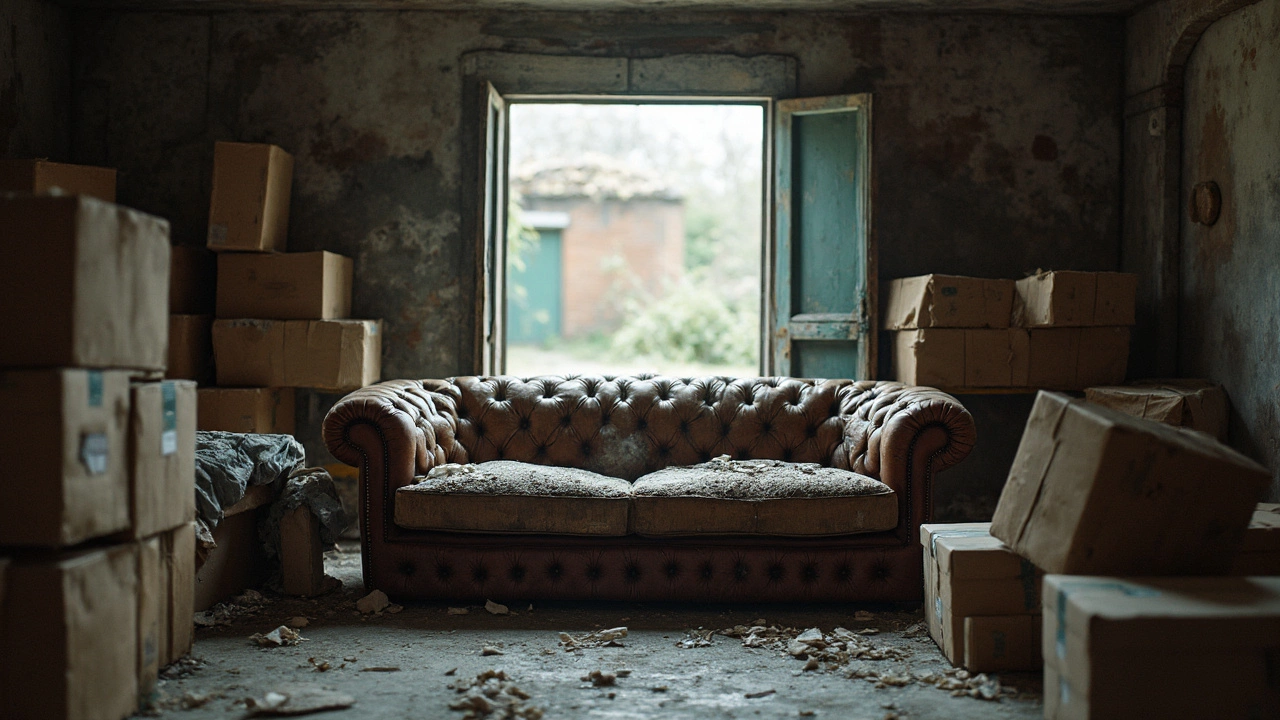Mold loves a good couch almost as much as you do—especially when it’s tucked away in a damp storage unit. Most folks are surprised when they pull their sofa out of storage and find fuzzy patches or a musty smell that just won't go away.
The biggest culprit? Moisture. It sneaks in from humidity, leaky storage units, or even just packing up your couch slightly damp. Mold spores don’t need much—they’ll set up camp anywhere soft, dark, and a bit wet.
If you're planning to stash your couch for any length of time, you’ve got to think beyond just tossing it under a tarp. Simple moves, like cleaning your couch before storage and making sure it's bone dry, can make a world of difference. Taking a few extra steps now saves you from the nightmare of scrubbing mildew or tossing your favorite seat in the trash later.
- Why Mold Loves Storage
- Warning Signs Your Couch Is At Risk
- Best Ways to Prep Your Couch
- Climate Control: Your Secret Weapon
- Cheap Tricks to Keep Mold Away
- What To Do If Mold Shows Up
Why Mold Loves Storage
Mold isn't picky. All it really wants is a steady supply of moisture, a little darkness, some warmth, and something soft to settle into—exactly what you’ll find in a storage unit full of couches and other furniture. Once conditions line up, those tiny mold spores in the air can land and grow on fabric, wood, and even leather.
Storage units, especially the cheaper non-climate-controlled ones, can be breeding grounds for mold. Even a tiny leak from a roof, a window, or even a spill you forgot to clean before storing the couch can trap moisture. Without airflow and sunlight, that moisture isn't going anywhere, and mold can start growing in just 24-48 hours. Sounds fast, right? It gets worse in summer when high humidity ramps up the risk.
| Factor | How It Helps Mold |
|---|---|
| Humidity over 60% | Keeps fabrics and stuffing damp |
| Poor ventilation | Moist air gets trapped |
| Organic material | Mold eats natural fibers and wood |
| No sunlight | Mold thrives in darkness |
A recent survey by a major self-storage company showed that 40% of damage claims in their units were linked to mold and moisture issues. That means you’re not alone if you’ve dealt with this headache before.
Basically, stuffing a couch in a storage unit is like serving mold an all-you-can-eat buffet. The fabrics, the padding, even those crevices you never clean—mold loves them. Once it starts, it can break down fibers, leave endless stains, and stink up your entire storage unit and everything else inside.
Warning Signs Your Couch Is At Risk
Even if your storage spot looks dry, your couch can start growing mold if you’re not careful. The trouble usually starts with small things that are easy to miss. You want to keep an eye out for these warning signs before you stash your sofa away—or while it’s sitting in storage.
- Musty Smell: If your couch gives off an earthy or damp odor, that’s mold’s calling card. Even a faint smell means spores are already getting comfortable.
- Humidity Above 60%: Mold likes humidity that’s anything above 60%. Get yourself a cheap humidity gauge and check the storage area. If the number’s creeping up, your furniture is at risk.
- Dampness or Water Stains: Run your hand along the cushions or fabric. Feel any clamminess or spot water stains? Mold follows moisture. That’s a sign things could turn bad fast.
- Discoloration or Spots: Tiny green, black, or white patches—especially in the corners or under cushions—are early signs of mold growth. Don’t brush these off as ordinary stains.
- Poor Airflow: Mold picks storage rooms with no ventilation. If your unit is stuffy or has no fans or vents, your couch might be the next victim.
According to a study by the American Society of Home Inspectors, 55% of self-storage units have humidity levels above safe recommendations during the summer.
| Sign | Why It Matters |
|---|---|
| Musty Smell | First warning that spores are present |
| Humidity > 60% | Mold thrives above this level |
| Water Stains | Proof of past leaks or spills |
| Discoloration | Visible mold colonies starting |
| Poor Airflow | Creates stale, damp conditions |
Don’t ignore these early alerts. Catching problems before your couch goes into storage or while it’s still easy to pull out is way easier than cleaning up a full-blown mold invasion.
Best Ways to Prep Your Couch
If you want your couch to survive storage without a trace of mold, you have to do more than just cover it and hope for the best. Most storage mistakes come from skipping small but essential steps. Here’s how to prep in a way that’ll actually keep your couch safe and dry.
“Moisture is enemy number one for upholstered furniture in storage. Even a little leftover dampness makes a perfect home for mold,” — Institute of Inspection Cleaning and Restoration Certification (IICRC)
Start by giving your couch a deep clean. Wipe down any leather or vinyl, and vacuum every inch—even between cushions and under the skirt. Don’t just bank on a quick wipe; dirt and crumbs hold moisture. For fabric couches, a cleaner designed for upholstery works great. If you can, let everything air out for a full day before the next step.
- Dry, Dry, Dry: Always make sure the couch is completely dry before storage. If you’ve cleaned it with water or cleaner, let it air out for at least 24 hours. This is the #1 way to avoid mold.
- Disassemble What You Can: Take off legs, remove cushions, and store small parts separately. Not only does this make moving easier, but it also helps airflow and stops moisture settling in creases.
- Wrap Wisely: Skip the plastic wrap—plastic can trap any moisture and turn your couch into a mold factory. Go for breathable moving blankets or sheets, which shield from dust while letting the fabric breathe.
- Lift It Up: Don’t let your couch sit flat on concrete. Put it on pallets or blocks to keep it away from damp floors. Concrete sweats, which means moisture can travel up and soak the fabric without you even noticing.
| Prep Step | Why It Matters | Pro Tip |
|---|---|---|
| Deep Clean | Removes moisture and dirt | Use fabric-safe cleaner |
| Drying | Stops mold before it starts | Fan or sun works wonders |
| Lift From Floor | Protects from damp spots | Look for wood pallets |
| Cover With Sheet | Allows air flow | Avoid plastic at all costs |
One last thing: always store your couch in a spot with good airflow whenever possible. Even in a storage unit, try to arrange items so air can get around the fabric, not just trap it in a corner. If you follow these tips, you’ll seriously cut your chances of pulling out a moldy mess when it’s time to bring your couch back home.

Climate Control: Your Secret Weapon
If you want to keep your couch safe in storage, climate control is the best move you can make. Mold doesn’t just show up for no reason—it needs humidity and still air to thrive. A basic, windowless storage unit acts like a greenhouse, especially in the summer. If the place gets hot and muggy, your furniture’s on the fast track to mold central.
Climate-controlled storage units fight back by keeping temperature and humidity in check year-round. Most places set the temp between 55 and 80 degrees Fahrenheit and hold humidity under 55%. That’s the sweet spot where mold loses its grip. Regular storage units just can’t do that. Even if you’re storing your couch at home in a garage or basement, a small dehumidifier can do wonders.
Here’s what to look for if you’re serious about keeping that sofa fresh:
- Pick a storage unit that says “climate-controlled” right on their website or signs. Don’t just hope—ask about the temperature and humidity settings.
- If you're using your own space, grab a humidity gauge (they’re cheap) and keep moisture under 55%. Plug in a dehumidifier if you need to.
- Keep the storage area clean, and make sure nothing is leaking—no pipes or roofs dripping onto your stuff.
People often try to cut corners to save a little money, but replacing a moldy couch costs way more than paying for the right storage. Think of climate control as insurance: you might not see what it’s doing, but your furniture will thank you later.
Cheap Tricks to Keep Mold Away
You don’t have to drop a bunch of cash to protect your couch from mold when it’s in storage. A little creativity can go a long way in keeping those funky spores at bay. Most tricks use things you already have at home or can pick up at the grocery store.
First off, let your couch breathe. Don’t wrap it in plastic—this actually traps moisture. Instead, cover it with an old cotton sheet. This lets air move while keeping dust and bugs away.
Next, grab some baking soda. Just sprinkle it over your couch’s fabric parts before covering it up. Baking soda helps soak up lingering smells and moisture. If your couch will be stored for months, toss a few open boxes of baking soda under and around it—it’s cheap, easy, and actually works.
If you’re worried about humidity, make your own DIY dehumidifiers. Fill old socks with uncooked rice, charcoal briquettes (the plain kind, not the ones with lighter fluid), or a few handfuls of silica gel (those little packets that come in shoe boxes are perfect). Set these around and under your couch to help pull moisture from the air.
You can also use white vinegar—no, don’t douse the couch in it, but keep a shallow bowl or two nearby. Vinegar soaks up odors and can help keep some types of mold from taking hold. Just don’t let it spill on the upholstery, or you’ll swap mold for a vinegar smell.
Need one more tip? Raise your couch off the ground. Use old bricks, wooden pallets, or anything solid, so air can flow underneath. This stops any ground moisture from sneaking into your couch’s legs and bottom.
What To Do If Mold Shows Up
Spotting mold on your couch for the first time always feels like a punch in the gut, but don’t panic. You’ve got some options to fight back and maybe even save your favorite place to binge-watch or nap.
First off, drag the couch outside if you can. More air and sunlight are your friends here—mold hates dry, sunny spots. If going outside isn’t possible, at least crack every window and turn on some fans to boost airflow. The goal is to stop mold from spreading.
Grab a mask and gloves before you start cleaning. Mold spores don’t mess around with your health. Once you’re suited up, scrape off any loose mold with a brush or even a vacuum that has a HEPA filter (just remember to toss or wash the vacuum bag right after).
Time to clean. Here are typical steps that actually work:
- Mix a simple cleaning solution: white vinegar is safe and tough on mold. Just pour it into a spray bottle undiluted.
- Spray the vinegar directly onto the moldy spots. Let it sit for at least 60 minutes.
- Wipe with a damp cloth and let the area dry completely. Repeat if you still see any mold.
- If you’re dealing with a serious case, try hydrogen peroxide (3% strength). Test it on a hidden spot before spraying, since peroxide can bleach some fabrics.
- Don’t forget to let cushions and couch frames dry in the sun if possible. UV rays can help knock out lingering mold spores.
Sometimes the smell hangs around even after the visible mold is gone. Baking soda can help—just sprinkle it over the fabric, let it sit overnight, then vacuum it up. If the mold comes back fast, or if the couch is covered in it, calling in a pro or cutting your losses might be smarter (nobody likes that, but safety comes first).
| Remedy | Effectiveness | Risk to Fabric |
|---|---|---|
| White Vinegar | 88% | Low |
| Hydrogen Peroxide (3%) | 90% | Medium (may bleach color) |
| Baking Soda | 65% | None |
| Professional Treatment | 98% | Depends on method |
So if you find mold, act fast. With the right cleaning steps, your couch can still have a lot more movie nights left in it.



